Step 3: Set Targeting (optional)
Hackle provides the ability to limit and customize users who participate in A/B testing. For example, the A/B test targeting rules can be set so that only Android users among mobile operating systems are allowed to participate. However, users who are manually allocated to a certain test group cannot be subjected to targeting. For more information on manual allocation, please check out Step 7: Register Test Devices for Manual Allocation(optional)
(Note) Users participating in an A/B test are subject to traffic allocation. For more information, see theTraffic Distribution document.
Conditions for using the targeting functionCheck your SDK conditions
- Supported languages for targeting: Android, iOS, JavaScript, React, React Native, Java/Kotlin, Python, Node.js
- Supported versions for targeting: iOS and React Native are 2.0.0 or higher, others are 2.1.0 or higher
- For more information about SDK versions and their functions, refer to the What is a SDK? document.
Check your plan
- Targeting is only available for paid plans (Pro plan and above).
Policies to follow
- When to set
When the experiment is in Draft mode. Targeting rules cannot be edited once the experiment starts.
- Default
If you do not set a target, all users will participate in the A/B test.
- Environment
Can only be set inProduction Environment .
- Target Rule
If you want to limit your audience to specific users, you need to start with at least 1 target rule.
You can have up to 10 target groups for an A/B Test. All target rules are subjected to an OR operator so that the user becomes the targetted user only if one of the target rules is satisfied.
For example, if we want to target users who observe at least one quarantine measure in a situation where they receive a questionnaire about compliance with quarantine rules, "users who use a new mask every day", "users who use hand sanitizer frequently", "users who frequently use soap and wash their hands", you only need to satisfy one of the rules.
- Conditions
A target group will have at least 1 condition from the point that it is created, and you can have up to 10 conditions within each target rule.
Each condition will have the AND operator applied and the targeting will only occur for a user that has all of the conditions satisfied.
For example, if you target Android users among mobile operating systems and users in their 30s, both the conditions "users with Android mobile operating systems" and "users in their 30s" must be satisfied.
Hence depending on your needs, you will either add a target rule or a target rule condition within a target rule.
- Property
Target Groups rules and conditions act on the pre-determined properties. Therefore, you should first integrate with the Hackle SDK and be able to collect the property keys and values to use.
For more information about properties, see the Properties document.
Composition of target rules and conditions
Important!Both the target rules and conditions consist of a combination of
property name + operator + property value.
For example, if you want to target Android users among mobile operating systems in a situation where users' operating systems are being collected via the property key osName, you can create the following combination.
- Property Key: osName
- Operator: One of the following
- Property Value: Android, android
The first combination created becomes the first (target) rule. Depending on whether you add another combination as an AND or an OR to these rules, you can create a target for a completely different user.
Let's take a closer look at the operators and AND/OR below.
Operator
Operators are used when setting conditions and serve to describe the relationship between property names and property values.\ Hackle provides a total of 22 operators, you must select an appropriate operator according to the type of property value of the selected property name.
Please refer to the table below for more details.
Property Value Type | Operator | Possible Number of Property Values |
|---|---|---|
String | Is any of | Multiple selection possible |
String | Is none of | Multiple selection possible |
String | Starts with any of | Multiple selection possible |
String | Starts with none of | Multiple selection possible |
String | Ends with any of | Multiple selection possible |
String | Ends with none of | Multiple selection possible |
String | Contains any of | Multiple selection possible |
String | Contains none of | Multiple selection possible |
Number | = | Multiple selection possible |
Number | ≠ | Multiple selection possible |
Number | >= | Single selection allowed |
Number | <= | Single selection allowed |
Number | > | Single selection allowed |
Number | < | Single selection allowed |
Boolean | When True | Unselectable (operator includes property value 'True') |
Boolean | When False | Unselectable (operator includes property value 'False') |
version = | Version | Single selection allowed |
version ≠ | Version | Single selection allowed |
| version > | Version | Single selection allowed |
version ≥ | Version | Single selection allowed |
| version < | Version | Single selection allowed |
version ≤ | Version | Single selection allowed |
Example
If you want to target users who live in a metropolitan city, as long as the user is living in one of the six metropolitan cities, you can define the following rule like this:
Creating a rule for [users residing in a metropolitan city]
- Property key: Region (The property value of the region is String type)
- operator: one of the following
- Property values for 'next' spoken by the operator: "Dallas Metropolitan City", "New York Metropolitan City", "Los Angeles Metropolitan City", "Chicago Metropolitan City", "Houston Metropolitan City", "Washington Metropolitan City"
AND and OR
The two AND and OR operands have the following meanings:
-
AND\ Both operands must be satisfied to be included in the targetted users.\ For example, if 'Android users among mobile operating systems AND users with addresses in Seoul', only users with addresses in Seoul ** among users using mobile devices with Android operating systems are targeted.
-
OR\ If only one of the operands is satisfied, it is included in the targetted users.\ For example, if 'Android users OR address in Seoul among mobile operating systems', users who use mobile devices with Android operating system or users whose address is in Seoul are targeted.
AND and OR operands in Hackle's targeting
- The AND operator is used when adding conditions to a rule. Since multiple conditions must be satisfied to be included in the target, the more AND operator is used, the narrower the target's scope.
- The OR operator is used when adding a rule. The more you use the OR operator, the wider the target, because if only one of the rules is satisfied, it is included in the target.
Setting up targeting rules on the dashboard
When creating A/B tests
You can set a target when creating a new A/B test.
You don't necessarily have to set it up during the step you create your A/B test!You can set the rules after creation or change what you set up from the initial stage.
On the Create A/B Test screen below, you will find Audience Targeting at the very bottom.\
The default is set as All users.
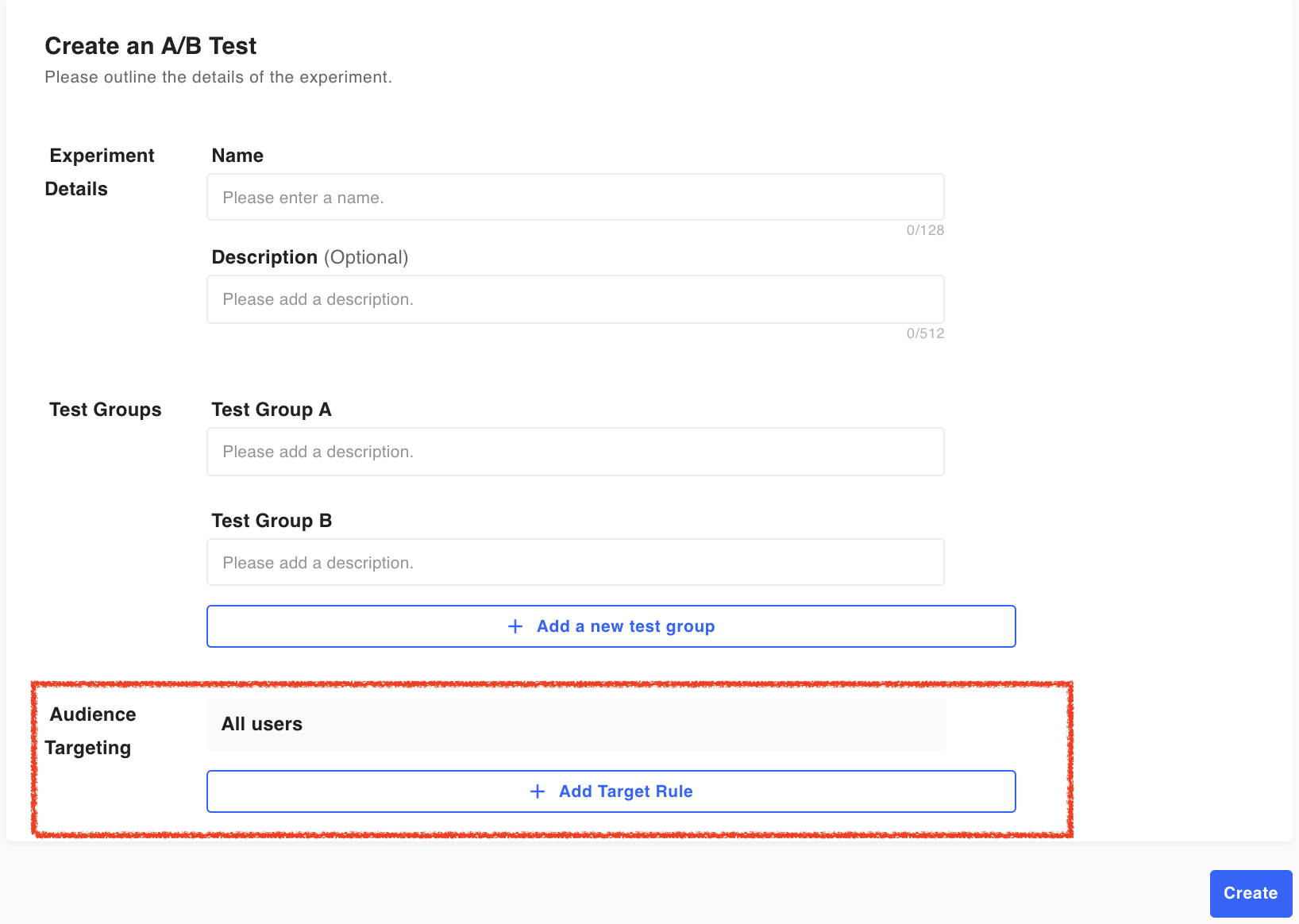
By pressing the + Add Target Rule button, you can set the first condition of the first rule as shown in the screenshot below.

The values to input or select and the description of each button are as follows.
- Property key
- Operator
- Property value
- Add an and condition
- Add new rule
If you press the + Add an AND condition button in 4, the condition is added to rule 1 as shown in the screenshot below, followed by the + Add new rule in button 5 to add rule 2 as shown in the screenshot below.
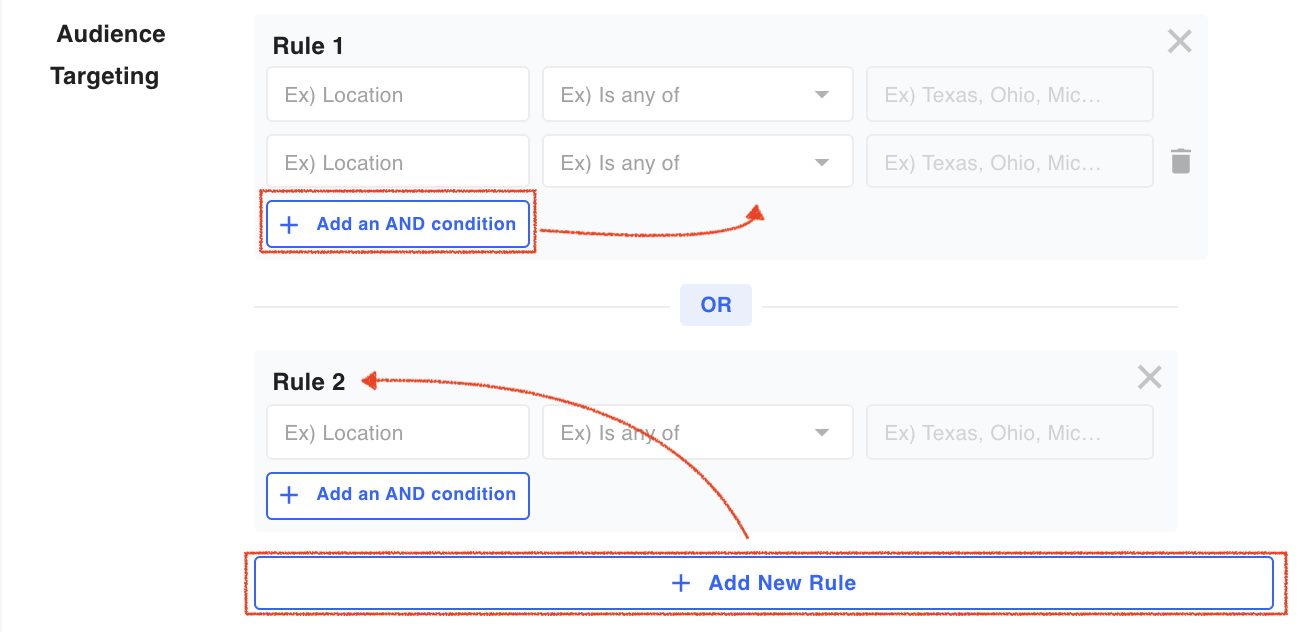
As mentioned earlier, a rule can have up to 10 conditions, and targeting can have up to 10 rules.\ Don't forget that it's the AND operator when adding conditions, and the OR operator when adding rules.
After entering the information required to create a test and setting up targeting, click the Create button to complete the setup.
After creating a new A/B test
You can view A/B Test targeting setup information in the upper common area of the Detail section.\
If you look at the right side of the setting information, there is a button called Set Targeting. By pressing this button, you can set the target or edit the content already set.
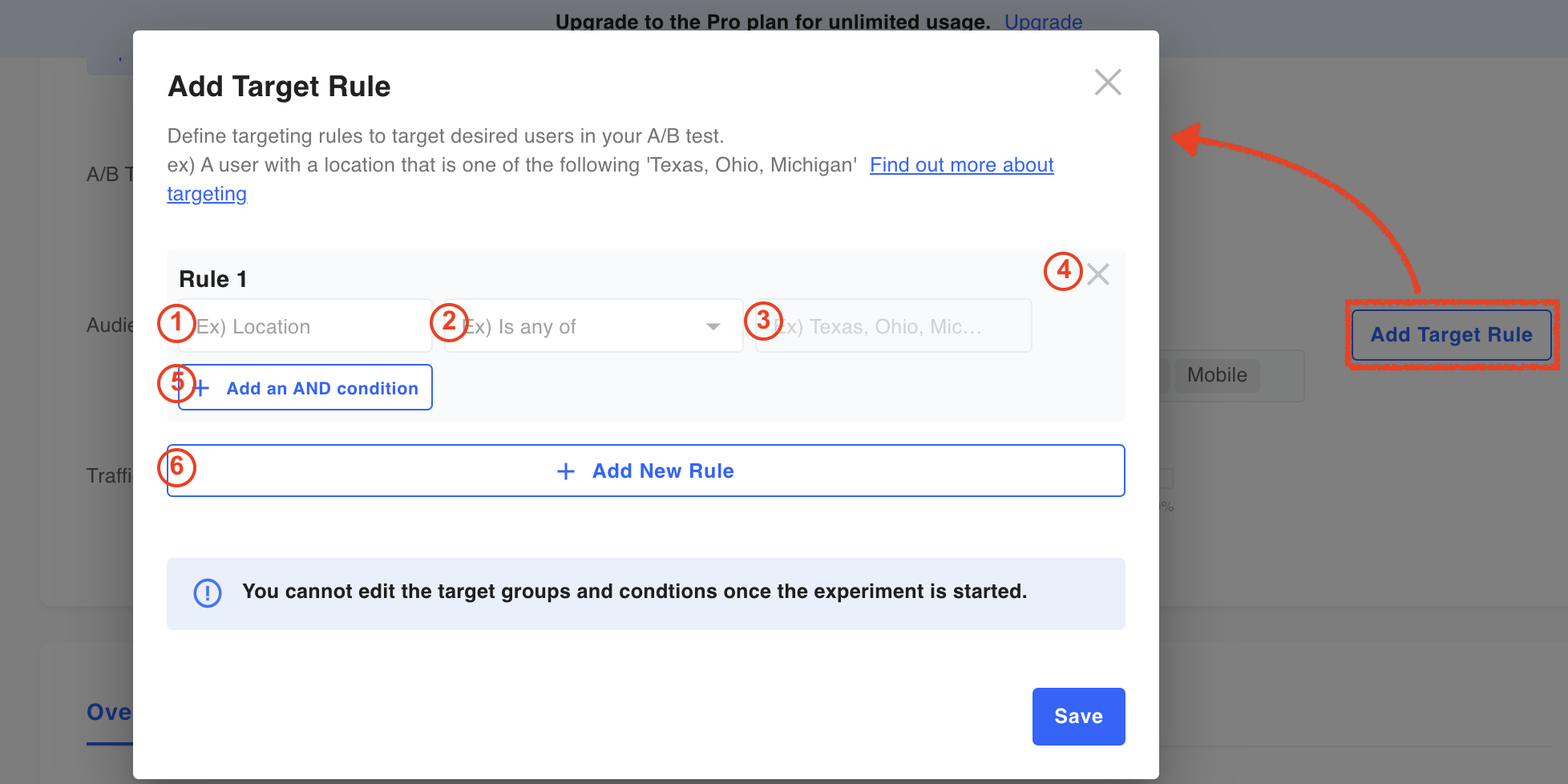
When setting, the values to be input or selected and the description of each button are as follows.
- Property key
- Operator
- Property value
- Delete rule
- Add an AND condition
- Add new rule
If you click the + Add an AND condition button in 5, a condition is added to rule 1 as shown in the screenshot below,
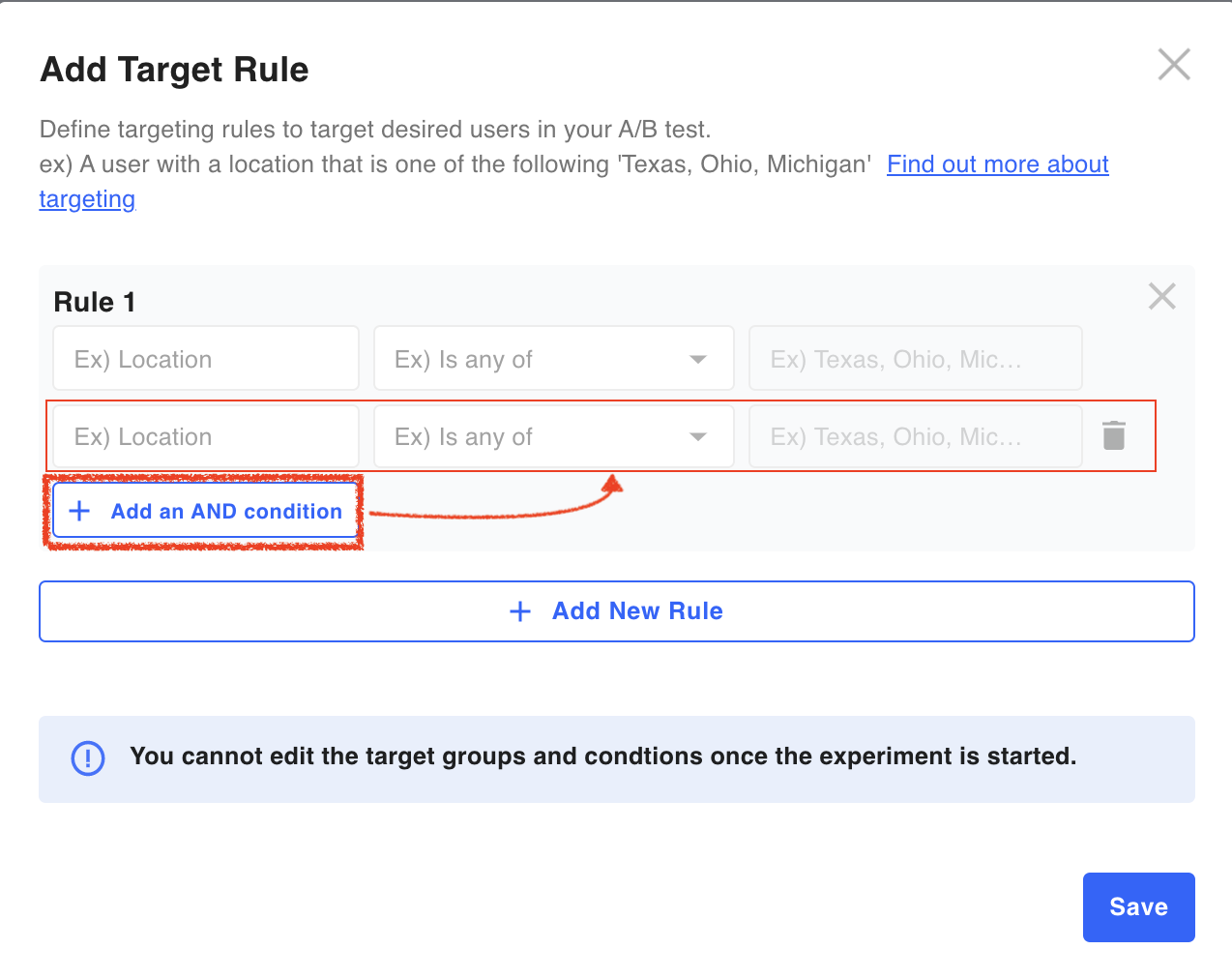
Then click the + Add New Rule button 6 to add Rule 2.
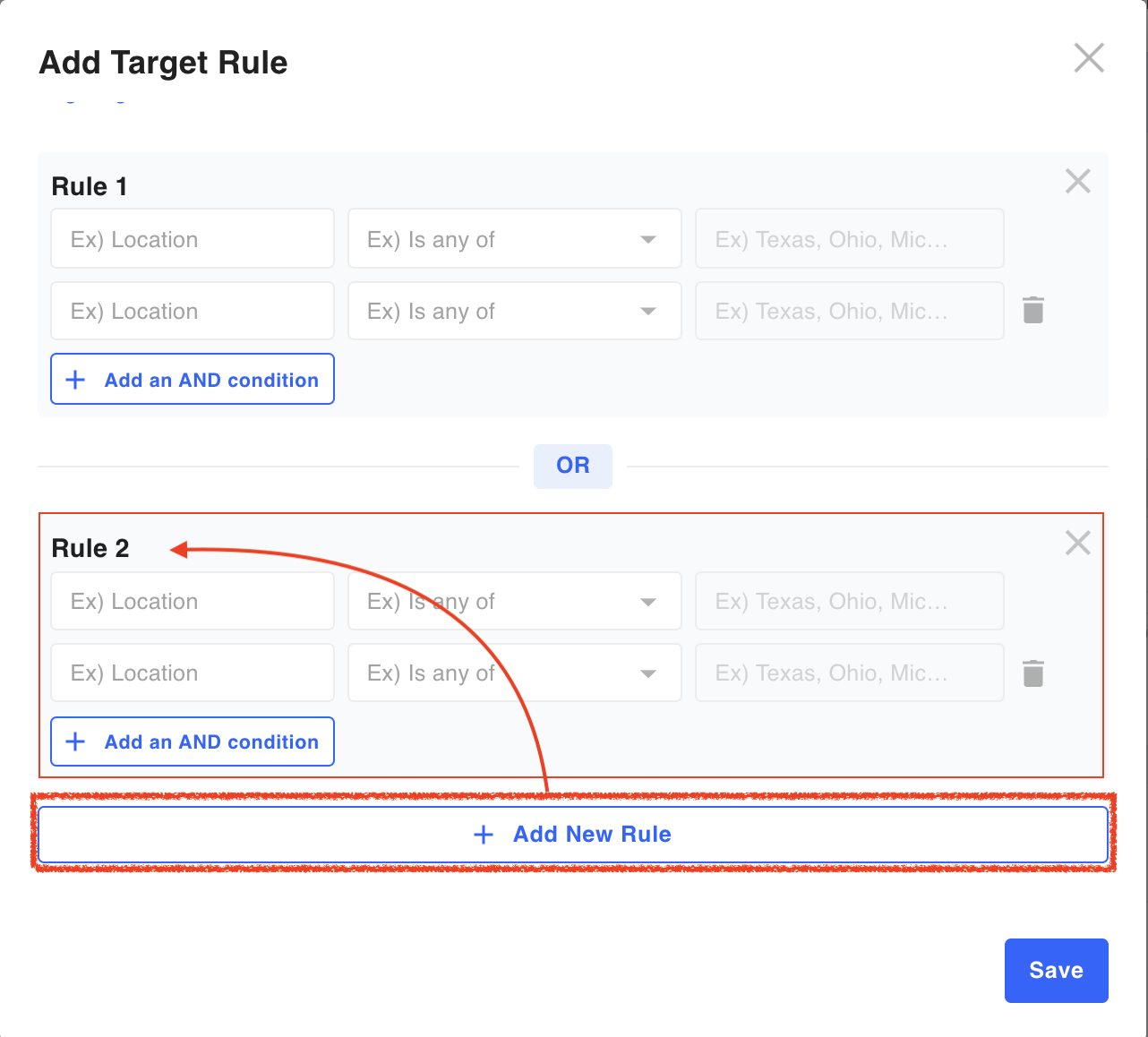
As mentioned earlier, a single target rule can have up to 10 conditions, and your actual targeting can have up to 10 rules.\ Don't forget that it's the AND operator when adding conditions, and the OR operator when adding rules.
After entering the necessary information to create the test and setting the targeting settings, click the Save button to complete the setup.
View settings in dashboard
You can view A/B Test targeting setup information in the upper common area of the A/B Test Details.\ However, target setting and setting changes are possible only in the ready state, so there is a slight difference in the contents displayed depending on whether the A/B test is in preparation or otherwise.
No target rules set (0 rules)
If you don't set a target, i.e. if the rule is 0, you don't restrict users to participate in A/B testing, so you're targeting all users.
when the A/B test status is in Draft mode
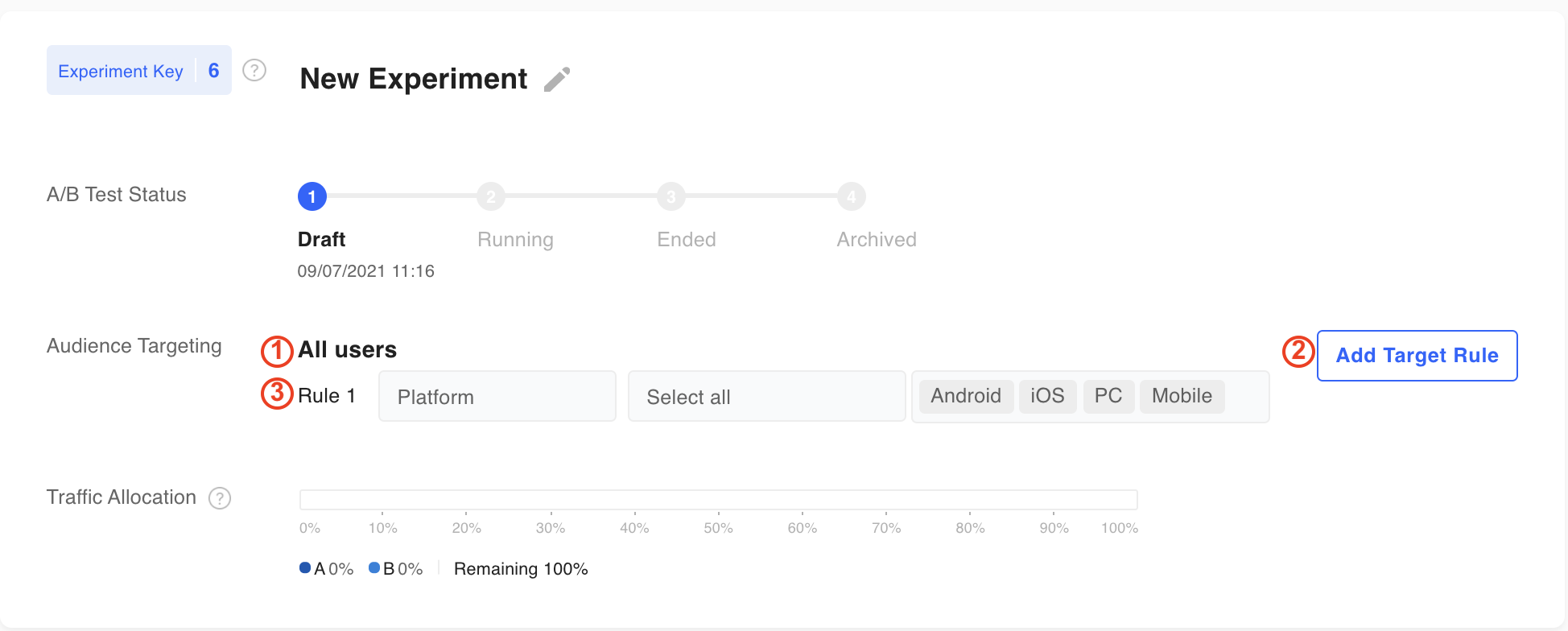
① shows that the targeting is applied to all users.\ You can set the target through the Target setting button in ②.\ You can see an example rule in ③. This is not a real rule and is just an example of what it would look like when you set up a rule.
If the A/B test status is running
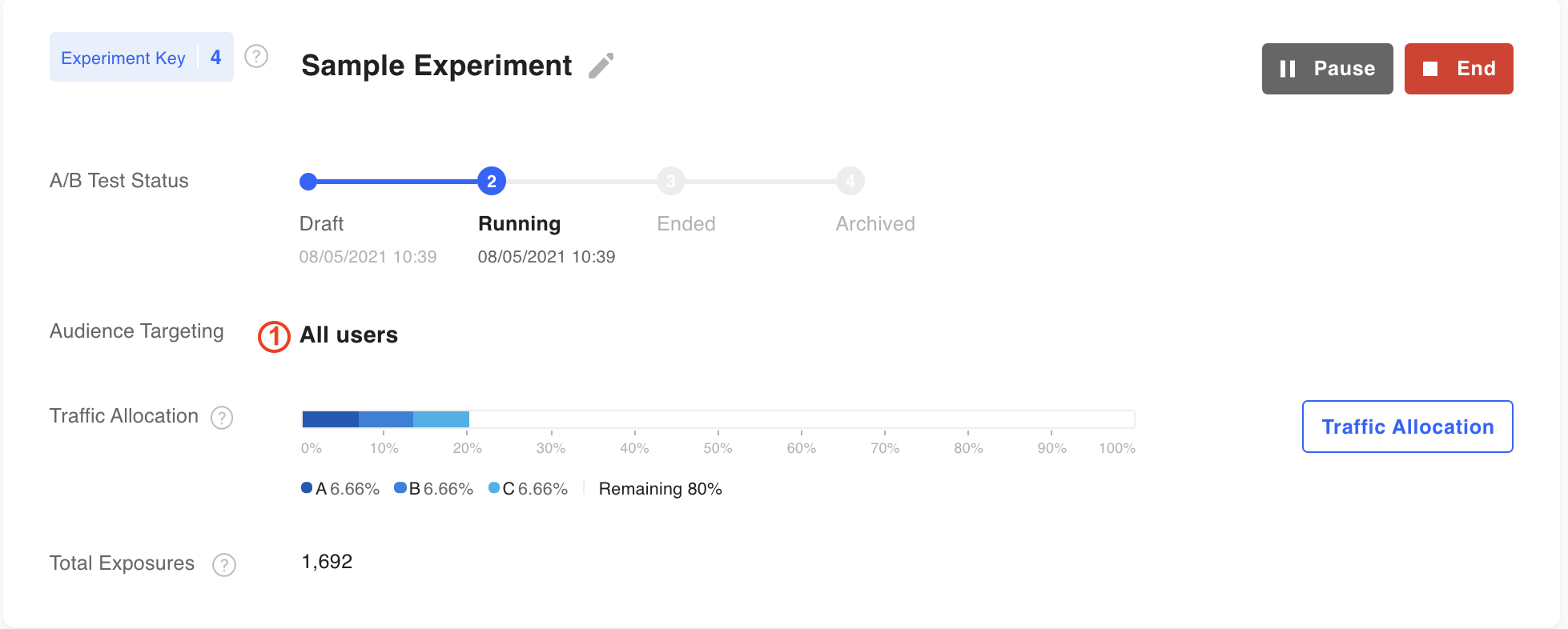
① shows that the experiment is for all users.\ However, there is no additional information to show because target setting is not possible.
Set target (1 or more rules)
If the target is set, it has at least one rule because it limits the users who will participate in the A/B test.
when the A/B test status is in Draft mode
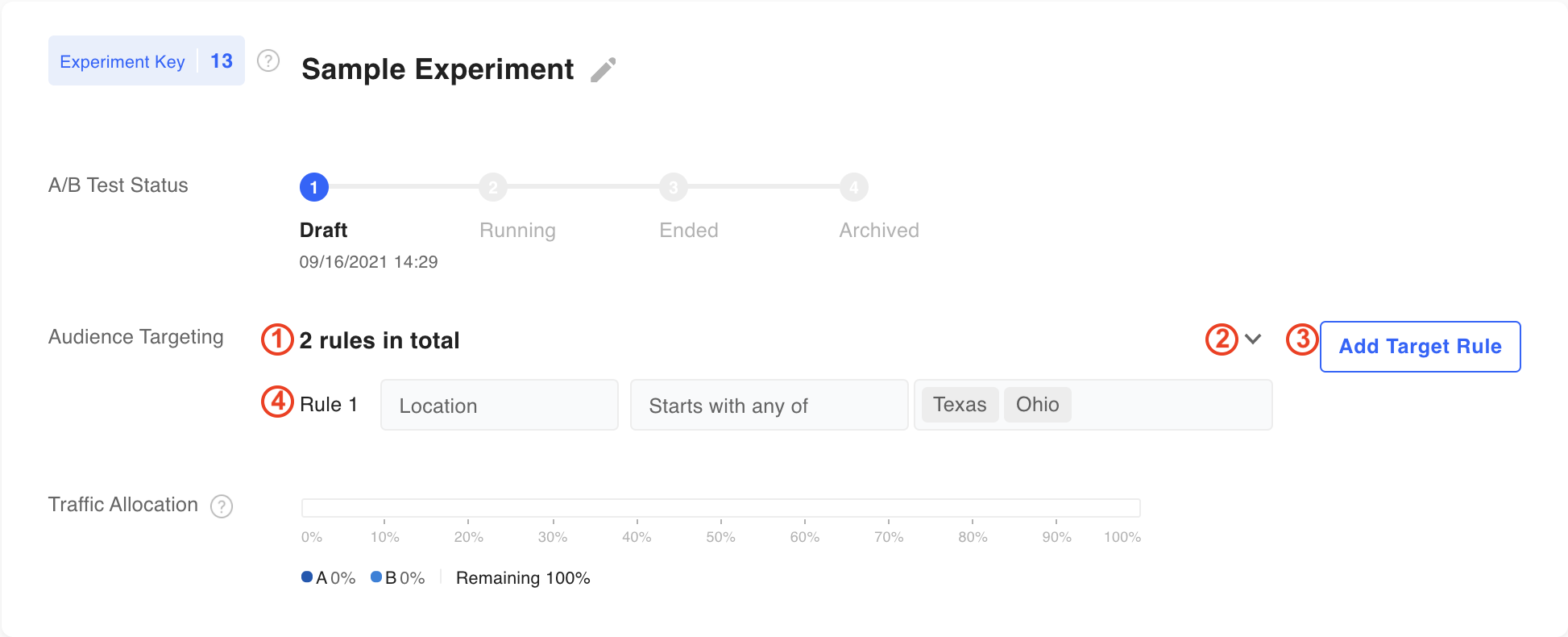
Shows how many rules are set in ①.\ ② means that the rules are folded. It basically leaves the whole rule out without showing it.\ You can set the target through the targeting setting button in ③.\ You can preview the rules in ④. Shows condition 1 of rule 1. To view additional information, click ② to expand it.
Below is an expanded example.
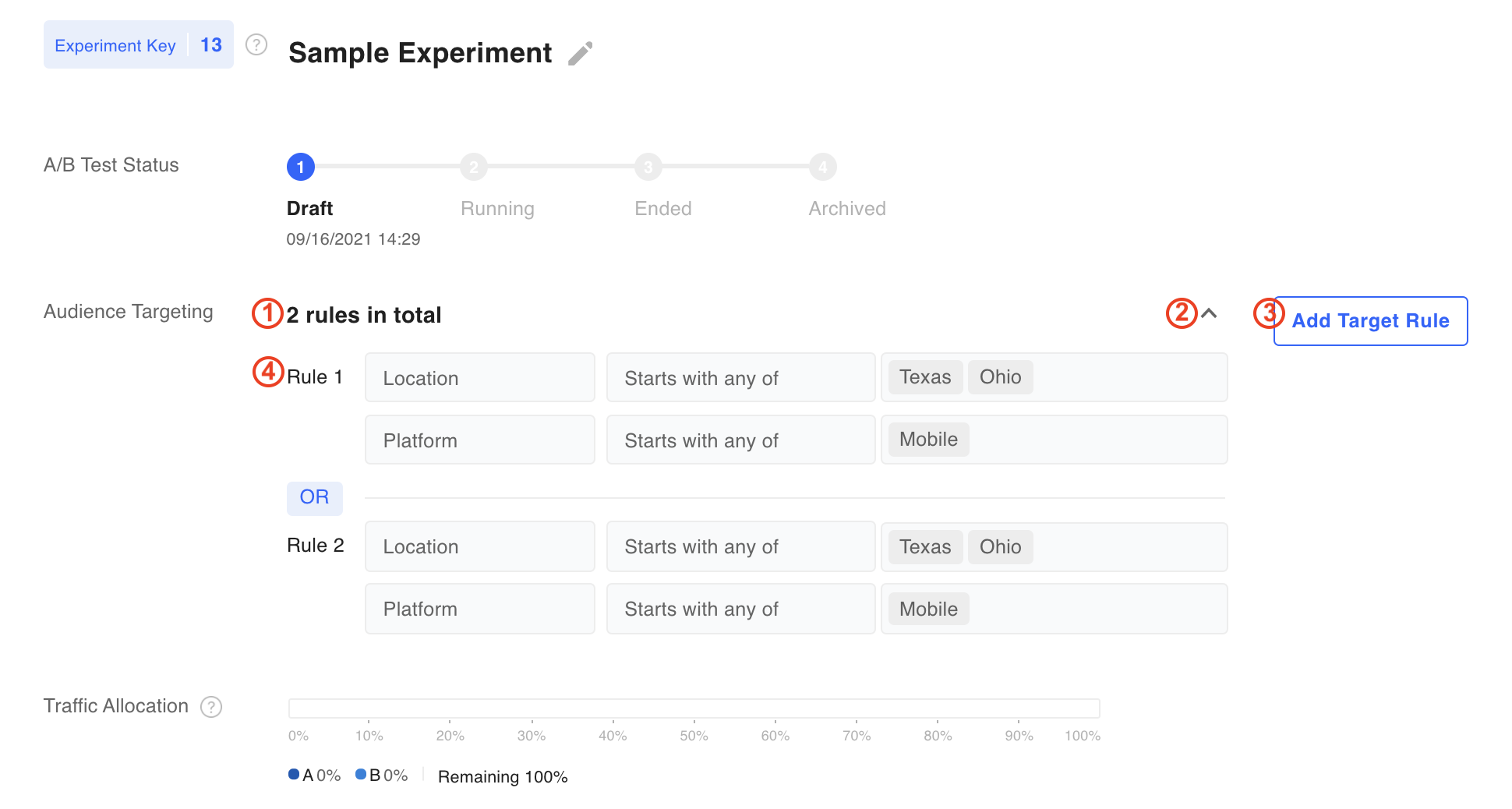
When expanded, ① and ③ are the same, but the direction of ② is reversed when it is expanded.\ You can also see all the rules in ④.
If the A/B test status is in draft mode
③ The Set Targeting button is not visible because it is not possible to set the target. Everything else is the same.
Updated 4 months ago
